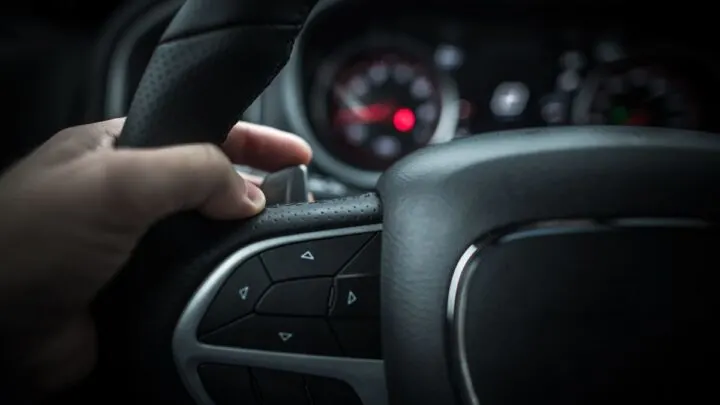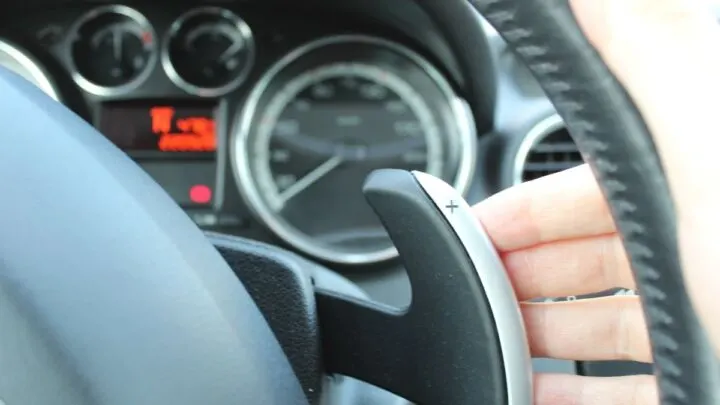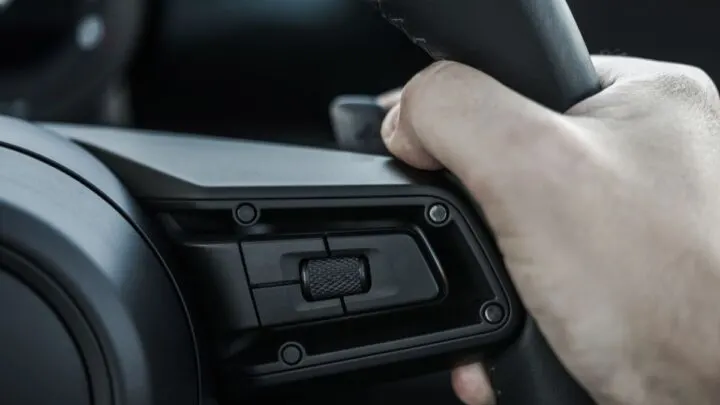Notice the plus and minus signs on your steering wheel. Get the lowdown on what they mean and how they can enhance your driving experience. Let’s steer into the details!
The plus and minus buttons on a steering wheel are called paddle shifters. They allow you to manually shift the vehicle up or down without needing to remove your hands from the wheel, making for safer and quicker gear shifts.
You might have them even if you’ve got an automatic transmission. They’ll let you have a little more control over the shifting action while driving.
Let’s take a closer look at what paddle shifters do, and how to properly use them.
Table of Contents
What Are Car Paddle Shifters?
A lot of modern cars have something called paddle shifters. They’re located right behind the wheel. The one on the left is the minus “-” shifter. And, the one on the right is the plus “+” shifter.
The “+” shifter upshifts the transmission while the “-” shifter downshifts.
Really expensive cars use them a lot. But, they’re the same as the ones in your sedan. The only difference would be their responsiveness.
Pulling on the + paddle shifter moves you up a gear. And, pulling on the – paddle shifter moves you down a gear. You can use them to maintain your RPMs at a certain level.

When Should You Use Paddle Shifters
There are a few advantages to using a paddle shifter. Since they let you control the gearing, you can downshift for hills. Cars usually make it up hills easier whenever they’re in a lower gear.
Or, you can use the downshifters to lower your gearing while going downhill. That lets you apply a little engine braking. It’ll keep you from going too fast. And, you’ll preserve your brake pads at the same time.
Did you know that paddle shifters can be extremely useful when towing as well? Sometimes, you’ve got to manually adjust the gears while you’re towing to help adjust for the terrain.
When your RPMs get too low, shift the gears down. That should boost your RPMs, and it’ll keep you in the ideal range.
Most cars produce maximum power at a specific RPM range. Generally, that’s somewhere between 2,000 and 3,000 RPMs.
Keeping your RPMs low can also help to boost your fuel economy. Try shifting up to lower your RPMs. Keeping your RPMs too low could put too much of a strain on your engine, though.
That would cause excessive wear and tear, unfortunately.

How to Use Paddle Shifters
Using paddle shifters is relatively straightforward. You’ve just got to pull on them to make them work.
Pulling on the left side will make your car shift down a gear. Pulling on the right side will make it shift up a gear.
Downshifting lowers your gear. And, by lowering the gear, you’ll notice the RPMs increase!
Also, it is easier to accelerate while going uphill. Keeping your car in lower gear also helps you to apply engine braking.
Engine braking slows down your car without having to apply the brakes. You can take advantage of this to preserve your brake pads. Lower the gears while you’re going downhill.
You’ll stop going as fast without having to touch the brake pedals at all!
Upshifting raises you up a gear. It’ll also lower your RPMs most of the time. Lower RPMs use less fuel, too!
So, you can use the paddle shifters to control how much fuel you’re burning.
Raise the gears once you’re RPMs get above 3,000. That should keep you within the ideal range for power generation.
If you’ve never used paddle shifters before, try the following. Start from a complete stop. At that point, you should be in first gear.
Then, press the gas pedal lightly. You’ll hear the engine start purring, and your RPMs will begin to increase.
Keep an eye on the RPMs until they’ve made it above 3,000. In 1st gear, that doesn’t take long at all.
Once you’ve hit 3,000 RPMs, pull on the right shifter. That will raise you up into 2nd gear. Now, you’re going to do the same thing until you’ve reached cruising speed.
Keep an eye on the RPMs until they’ve hit 3,000 again. Then, pull on the right shifter one more time. You’ll be in 3rd gear at this point.
Most modern cars have either 5 or 6 gears. Continue shifting up each time you’ve hit 3,000 RPMs.
After hitting your top gear, you won’t be able to shift anymore.
Slowing down uses the same process. Apply the brakes lightly while keeping an eye on the RPMs. Don’t downshift when you’ve hit 3,000 RPMs, though.
Only shift down once you’ve hit somewhere around 2,000 RPMs. Once you’ve hit that, pull on the left shifter.
If you’re in 6th gear, you’ll lower down into 5th gear. You’ll notice the RPMs increase whenever this happens. Continue applying pressure to the brakes. Then, once the RPMs drop to 2,000 again, pull on the left shifter.
You’ll lower from 5th gear into 4th. Continue this same process until you’ve gone all the way to 1st gear. At this point, you should be almost stopped. Now, you can allow the RPMs to lower beyond 2,000.
Usually, your car will idle somewhere around 800 to 1,000 RPMs. So, they won’t go any lower than that.
Keeping the RPMs lower will let you generate more power, too. So, you can lower the gears ahead of a hill. That will make driving feel a little more responsive once you start going up.
When the RPMs are higher, your engine causes you to slow down. That’s called engine braking. Truckers use it a lot while they’re driving big rigs. But, you can use the same principles in your car as well.

How Paddle Shifters Make Driving Better
If you’ve driven a manual transmission, you know how it feels. You’ve got a little more control over the driving experience. Most modern cars don’t have a manual transmission, though.
You can still get a similar experience with an automatic. If they’ve got paddle shifters, you can control the car’s shifting. The one on the left side lowers the gear. And, the one on the right side raises it.
Lowering the gears will raise the RPMs. Raising the gears will lower them. Controlling the RPMs allows you to control how much power the engine produces.
It can give you more power for certain terrains. Or, you can use it to control your speed without braking.
![What Are The Plus and Minus On My Steering Wheel? [Paddle Shifters Explained!]](https://vehicleanswers.com/wp-content/uploads/2021/11/What-Are-the-Plus-and-Minus-on-a-Steering-Wheel.jpg.webp)